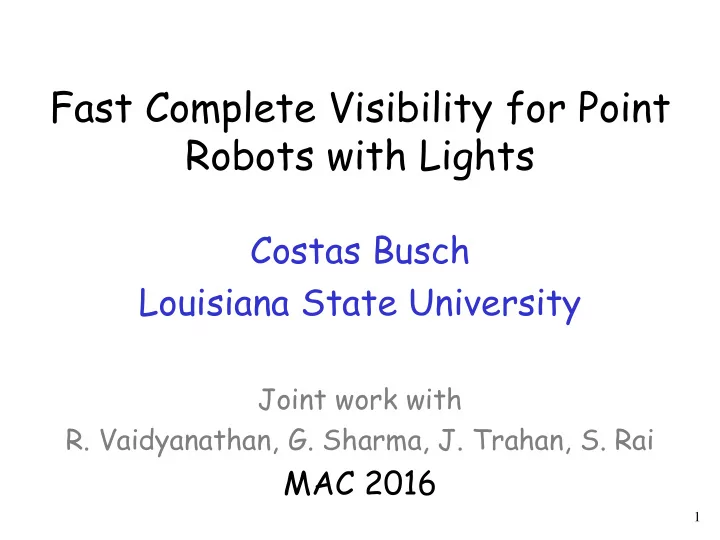

Fast Complete Visibility for Point Robots with Lights Costas Busch Louisiana State University Joint work with R. Vaidyanathan, G. Sharma, J. Trahan, S. Rai MAC 2016 1
Autonomous robots Look-Compute-Move cycles in the Euclidean plane 2
Autonomous robots Look - Sense the positions of other robots 3
Autonomous robots Compute – Determine destination based on sensed positions of other robots Thinking… 4
Autonomous robots Move – towards computed destination new target 5
Autonomous robots Robots are: Dimensionless Points • Anonymous (no unique identifiers) • Autonomous (no external control) • Oblivious (no memory of past) • Silent (no explicit communication) • No common coordinate system • 6
Autonomous robots Obstructed visibility Robots do not see through other robots p p does not see robots 7
The Mutual Visibility Problem Reach a configuration in which no three robots are collinear 8
The Mutual Visibility Problem Convex hull The solution is typically a convex hull 9
Robots with Lights Model • Proposed by Peleg, D. (2005) • Each robot has an externally visible light • Given an identical color set color set 10
Robots with Lights Model The robots communicate with each other • through colored lights (otherwise silent) The colors of lights are not erased at the end of • the LCM cycle (otherwise oblivious) color set 11
Robots with Lights Model Benefits: #robots N does not need to be known • -nodes always terminate Corresponds to model with no lights when • color set size = 1 12
Timing Fully synchronous all robots are active in a LCM round Semi-synchronous a subset of the robots is active in a LCM round Asynchronous there is no notion of round, each robot has its own notion of time for LCM cycle 13
Literature Solvability Di Luna et al. [SSS’14] • 6-color algorithm in the semi-synchronous setting • 10-color algorithm in the asynchronous setting Di Luna et al. [Information and Computation 2015] • 3-color algorithm Runtime Vaidyanathan et al. [IPDPS’2014] Fully synchronous setting 12-color algorithm with running time O(log n ) rounds • (possibility of collisions) Improved to O(1) rounds in [SSS’2016] with no • collisions 14
Two Approaches for Convex Hull Approach 1 [Di. Luna et al 2015]: Interior Depletion Shrink repetitively Gives low number of colors Approach 2 [Di Luna et al 2014]: Interior Depletion Edge Depletion (expand) Gives fast algorithms 15
Approach 1 Initial State 16
Approach 1 Convex hull robots get red color 17
Approach 1 Interior Depletion Robots move to edges of convex hull 18
Approach 1 Interior Depletion Robots move to edges of convex hull 19
Approach 1 Interior Depletion Robots move to edges of convex hull 20
Approach 1 Corner robots move inside preserving convex hull 21
Approach 1 Corner robots move inside preserving convex hull Yellow nodes don’t move again 22
Approach 1 Corner robots move inside preserving convex hull Yellow nodes don’t move again 23
Approach 1 Final configuration, nodes terminate 24
Approach 2 Initial State All robots are marked as “OFF” (gray color) 25
Approach 2 Convex hull corners are marked red 26
Approach 2 Interior Depletion Internal robots move to convex hull edges 27
Approach 2 Interior Depletion 28
Approach 2 Edge Depletion: edge robots move out 29
Approach 2 Side Depletion: side robots move out Robots that become internal get “OFF” color 30
Move to edge - again 31
Edge Depletion - again 32
Final Configuration 33
Fast Interior Depletion 34
Fast Interior Depletion free free 𝑠 free Free triangles – no other robot inside 35
Fast Interior Depletion 𝑠 Moves to a free edge 36
Fast Interior Depletion 𝑠 internal perimeter robots points There are many free edges: min 𝑅 2 , 𝑆 37
Fast Interior Depletion internal perimeter robots points There are many free edges: min 𝑅 2 , 𝑆 38
Fast Interior Depletion internal perimeter robots points There are many free edges: min 𝑅 2 , 𝑆 39
Fast Interior Depletion internal perimeter robots points There are many free edges: min 𝑅 2 , 𝑆 40
Fast Interior Depletion internal perimeter robots points There are many free edges: min 𝑅 2 , 𝑆 41
Fast Interior Depletion internal perimeter robots points There are many free edges: min 𝑅 2 , 𝑆 42
Fast Interior Depletion Total rounds for interior depletion: 𝑃 log 𝑂 43
Fast Interior Depletion For same edge collisions can be avoided pick a different target point according to relative position to edge 44
Fast Interior Depletion Problem: for different edges collisions may occur free Path collision 45
Fast Edge Depletion 46
Fast Edge Depletion Leftmost moves up 47
Fast Edge Depletion Go to the middle 48
Fast Edge Depletion 2 new edges 49
Fast Edge Depletion 2 new edges 50
Fast Edge Depletion 2 new edges Repeat process for new edges Total rounds for edge depletion: 𝑃 log 𝑂 51
Total time Total rounds for interior depletion: 𝑃 log 𝑂 + Total rounds for edge depletion: 𝑃 log 𝑂 rounds 𝑃 log 𝑂 52
Faster: O(1) rounds Interior depletion in O(1) rounds Edge depletion in O(1) rounds Avoids collisions 53
Interior depletion in O(1) rounds 1. Corner robots move inside to reveal themselves 2. Interior nodes move toward corner nodes to avoid collision 54
Revelation safe area 𝑑 𝑗 𝑀′ 𝑑′′ 𝑀 𝑧 𝑨 𝑣 𝑥 𝑑′ 𝑐 𝑏
Revelation safe area 𝑑 𝑗 𝑀′ 𝑑′′ 𝑀 𝑧 𝑨 𝑣 𝑥 𝑑′ 𝑐 𝑏 Now visible by all interior robots
Edge depletion in O(1) rounds Edge points move toward an arc 57
58
59
60
61
Convex 62
Future Directions Time analysis for other problems: • Robots without Lights • Fat robots Other metrics: • Total distance moved Lower Bounds 63
Thank You! 64
Recommend
More recommend